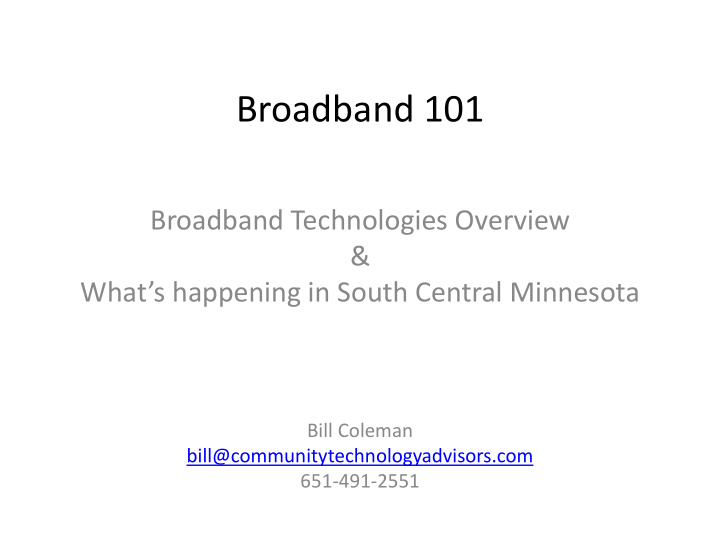



Broadband 101 Broadband Technologies Overview & What’s happening in South Central Minnesota Bill Coleman bill@communitytechnologyadvisors.com 651-491-2551
Broadband Trends • Broadband at the FCC – Recently reaffirmed by the FCC: • Anything less than 25 Mb/3 Mb is not broadband • Mobile cellular is not a substitute for a fixed connection – The FCC standard increased 30-fold between 2008 and 2016 • Broadband in Minnesota – 25/3 by 2022 – 100/20 by 2026 • Broadband in the marketplace – Some ISPs increased speeds 100-fold between 2008 and 2016 – Comcast just raised all speed tiers by 50 Mb – Gigabit service is increasingly available • Household use – Use more than 250 GB of data/month and rising – Have 13 connected devices; 50 devices by 2022 • Computers, phones, fitness devices, home security, medical devices, thermostats, personal assistants, watches, home appliances, cars, farm animals, sensors, tractors
Upload Speed Download Affordability Speed Broadband Latency Reliability Mobility Assessing Broadband Technologies “It’s more than just download speed!”
Digital Divide Index Combines demographic and connectivity data “Is your future dark or bright?” USA data Minnesota-only data Source: Purdue University, Robert Gallardo
Winning! Losing! As broadband becomes even more important, these trends will accelerate!
Note: New broadband maps will be out in mid-April!
Region Nine DEED OBD Border to Border Broad- band Grant Eligibility All red areas are a priority
Region Nine Broadband Infrastructure
Federal Broadband Subsidies for Larger Carriers (CAF II) affecting the region www.fcc.gov/re ports- research/maps/ caf-2-accepted- map/
(ACAM), a federal subsidy for Mid-size Carriers affecting the region www.fcc.gov/rep orts- research/maps/a- cam-offer-map/
FCC CAF II and ACAM Improvements • CAF II – Capital subsidies to CenturyLink, Frontier, Consolidated & Windstream – 10 /1 minimum • ACAM – Operating subsidies to NU-Telecom, BEVCOMM, Arvig and others – Requires minimum of 25/3, 10 /1 or 4/1 depending on costs • No requirement to serve everyone • Within 3,000 feet > 25 Mb or greater possible • At 10,000 feet = ~ 10 Mb • Copper condition affects carrying capacity over distance
Red circles = 3,000 foot radius = 25 Mb/3 Mb and higher Blue circles = 9,000 foot radius = between 25 Mb/3 Mb to 10 Mb/1 Mb FRONTIER’S LINDSTROM EXCHANGE
Those within the circles, about 10% of land area, would likely meet the 2022 state goal of 25 Mb/3Mb; no one would meet the 100 Mb/20 Mb 2026 state goal. FRONTIER’S LINDSTROM EXCHANGE
WIRELESS
Fixed Wireless • Improvements – Increasingly robust with fiber-fed towers, especially on the prairie – Many combinations of technologies and spectrum • Balancing of power and bandwidth • Licensed, lightly licensed and unlicensed • Challenges – Trees can eat wireless – Hills can hide wireless – Availability and cost of Internet backhaul
Test Question: What does this map show?
Cellular Issues • 4G/3G coverage can be spotty in rural away from highways • Bandwidth decreases with distance from tower • Beware of ** on “unlimited” data plans • 5G will require fiber to within 1,000 feet of customer
Satellite • Improvements – Increased speeds – Increased affordability • Challenges – Latency/delay affects advanced use • Virtual private networks • Teleworking • Skype/Facetime video apps – Weather affects reliability – Same unlimited** considerations as cellular
Fiber Infrastructure Investment – Is it a good choice? • Fiber to the Home costs between $4,000 and $12,000 per home • Seventy percent of homebuyers will not buy a home without a good broadband connection • A fiber-connected home increases in value by $3,000 to $7,000 • Well-connected residents and businesses save money in many ways, conservatively estimated at $1,500 per year • Customers switching from satellite/cellular packages to triple play FTTH report savings of $300 - $400 per month! • Wireless is on fiber for most of its path
What else costs about $10,000? Anyone can decide to buy some 10 year-old stuff on Craigslist! But one person cannot buy their own broadband network … we have to do that together!
Tools and Resources • DEED Office of • Blandin Foundation Broadband – Community Broadband – Grant program Resources Program – Robust Network Feasibility – Maps and data Study – Liaison with broadband – Broadband Communities providers Program • Federal Government – Blandin on Broadband Blog – USDA Rural Development & BF web site – US Commerce – NTIA • Others • Region Nine – Fiber Broadband Development Association Commission – Benton Foundation
DEED OBD Broadband Grants
Conclusions • RNDC – Wide variations in connectivity – Relatively few FTTH deployments – Strong reliance on fixed wireless in rural – Larger farms with fewer people, but more connected devices, sensors and livestock • Broadband Improvement Strategies – Subsidies are required for private sector investment • Response – April 12 Broadband Day on the Hill – www.mnbroadbandcoalition.com • L eadership determines “what’s good enough?”
Recommend
More recommend